UX and Product Design
I help bring worthy digital products to life, in higher-ed, agency and non-profit settings. I specialize in working for, and with, mission-driven organizations.
Here are a few case studies.
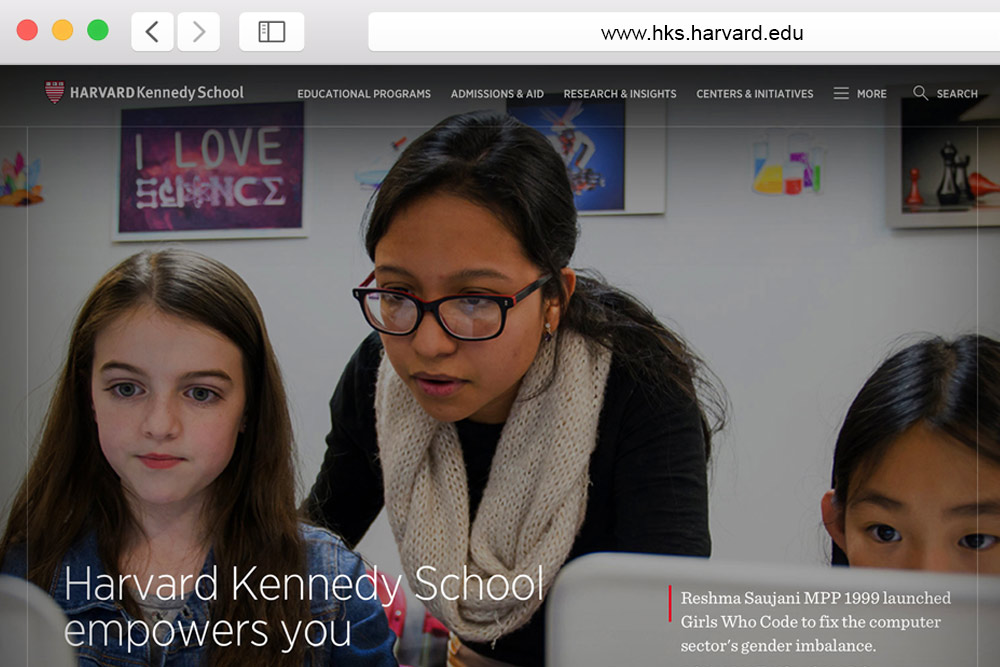
Creating Harvard Kennedy School's flagship website and digital ecosystem
Multiple years. Hundreds of stakeholders. Thousands of pages. Millions of visitors. I directed the team that brought a beautiful new flagship Harvard website to life.
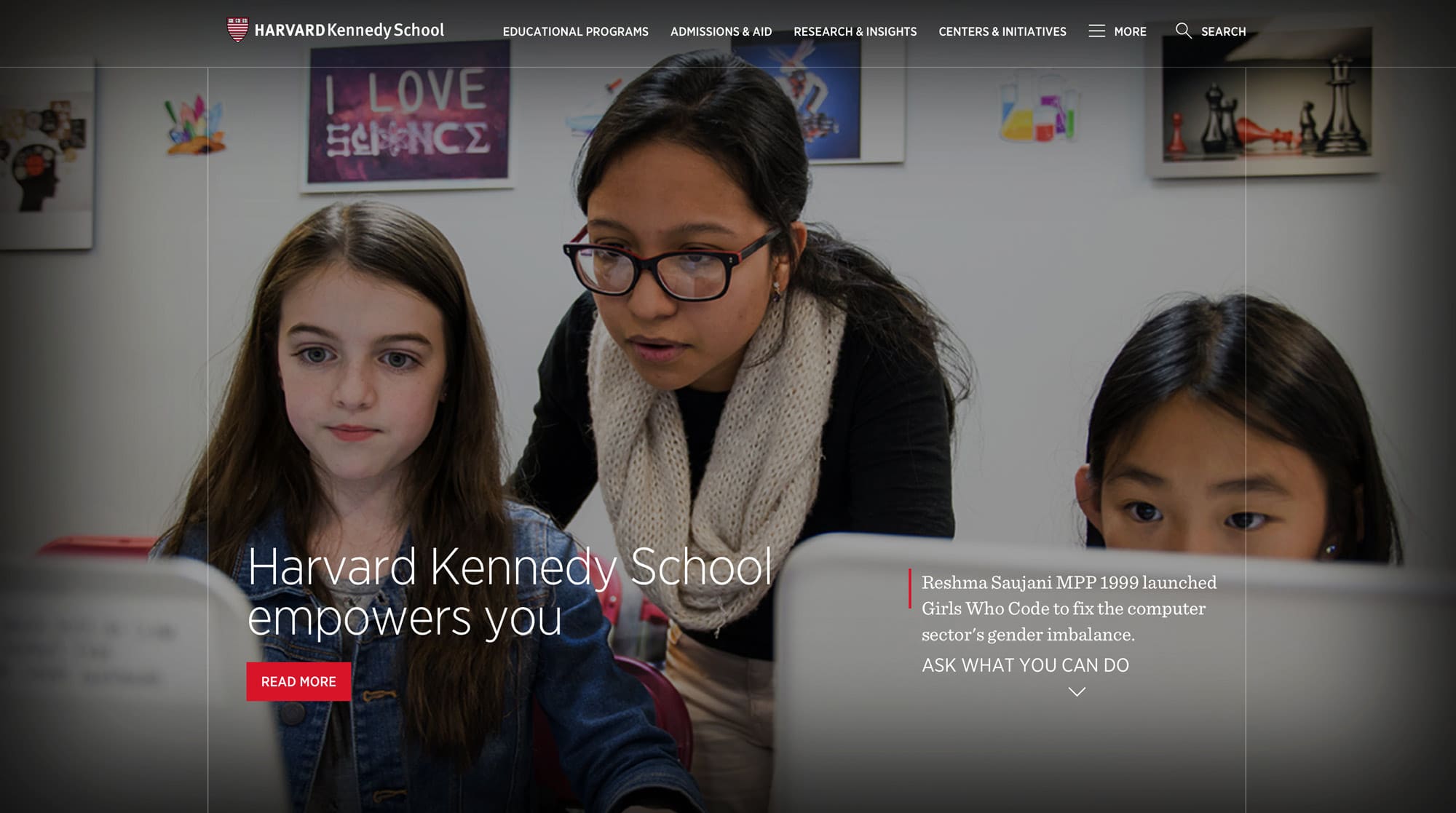
The Harvard Kennedy School is the preeminent school of public policy in the world. The HKS website is the school’s front door, hosting upwards of four million visitors every year, including prospective students, alumni, the media and the general public. I led the team that, over 2 years, re-conceptualized the 10,000 page website, streamlined the design, built the site on a cutting-edge Drupal 8 platform, and created a focused strategy for its ongoing use and management.
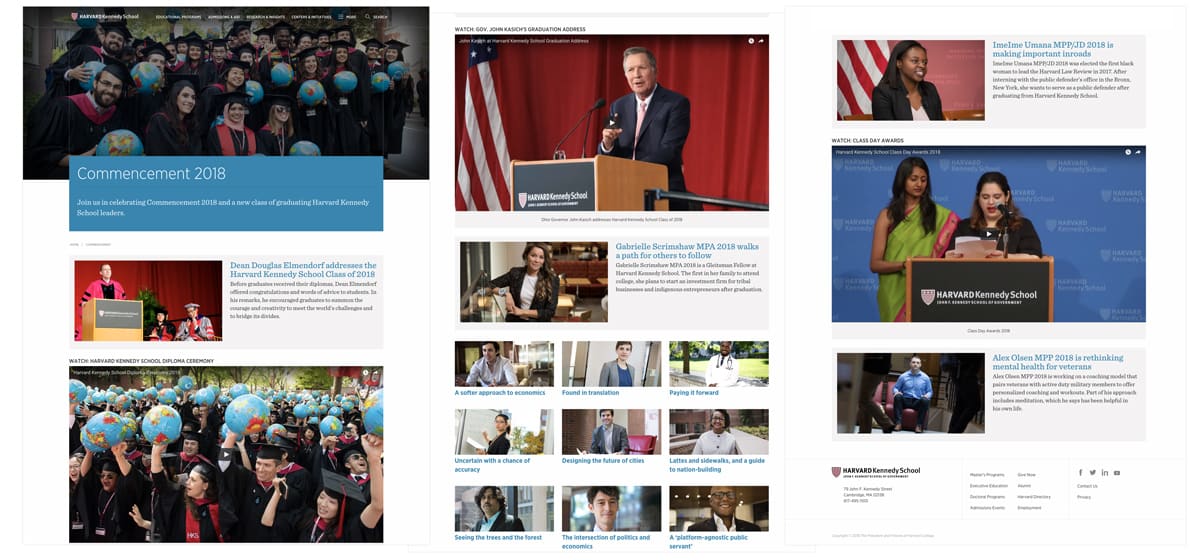
The new website makes space for richly developed, beautifully arranged content.
As the Associate Director for Web Strategy and Production at HKS since 2008, my role focused on bringing efficient practices, worthy content, and beautiful design to the Kennedy School’s online family of sites. By 2015, when the school began to prioritize its need for a new website, my knowledge and experience drove the project towards launch. I was tapped to write the project RFP, triage vendor responses, interview potential partners, form an internal project team, and recommend (with the help of a steering committee) a path forward.
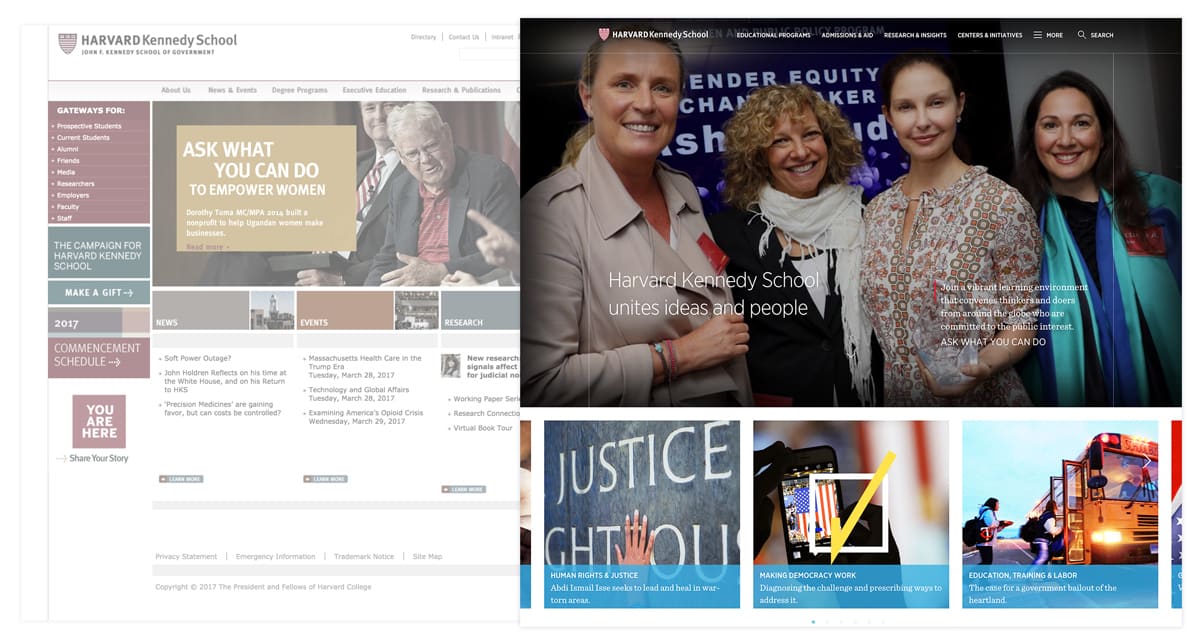
The hks.harvard.edu homepage before July 2017 (left) and after (right).
HKS is quite decentralized. Many units of the school have traditionally maintained their own sub-brands. The new website needed to account for this, giving each unit control over content and messaging, while allowing a larger identity to flourish.
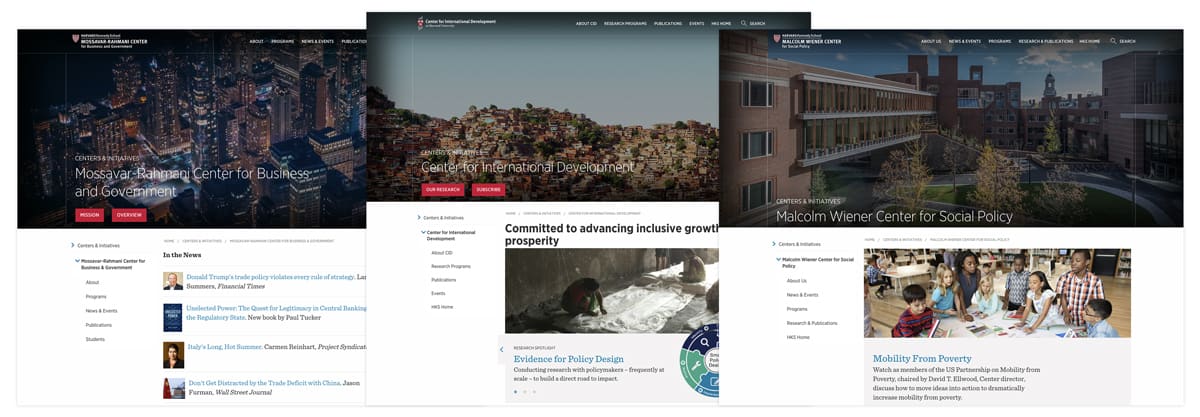
The site is designed to natively host multiple sub-branded identities, including semi-autonomous research centers and public-facing administrative offices.
The new web platform needed to support a publishing workflow for dozens of editors and contributors; at the same time, the school required a new unified taxonomy to organize content. I created the workflow plans and wrote the initial proposal for the system that would be ratified by faculty and leadership as the school’s official taxonomical structure.
Suffice to say, a large part of my job was working across the school to ensure the project was meeting (and exceeding) the needs of many different internal stakeholders.
My role included managing multiple vendor relationships, leading a school-wide team of internal staff, and presenting progress to senior-level management. Turnover and change affected each group, adding to the challenge. The project was underwritten by a six-figure budget for which my senior leadership team was accountable.
Our project team chose a forward-facing path: we decided to adopt the yet-to-be-released Drupal 8 platform during our development process. When we made the decision, Drupal 8 was still in beta. This created challenges, but also a path towards an extended lifespan for the site and the ability to work with modern new publishing tools. We committed to the approach, and weathered the challenges. It proved to be a worthwhile decision.
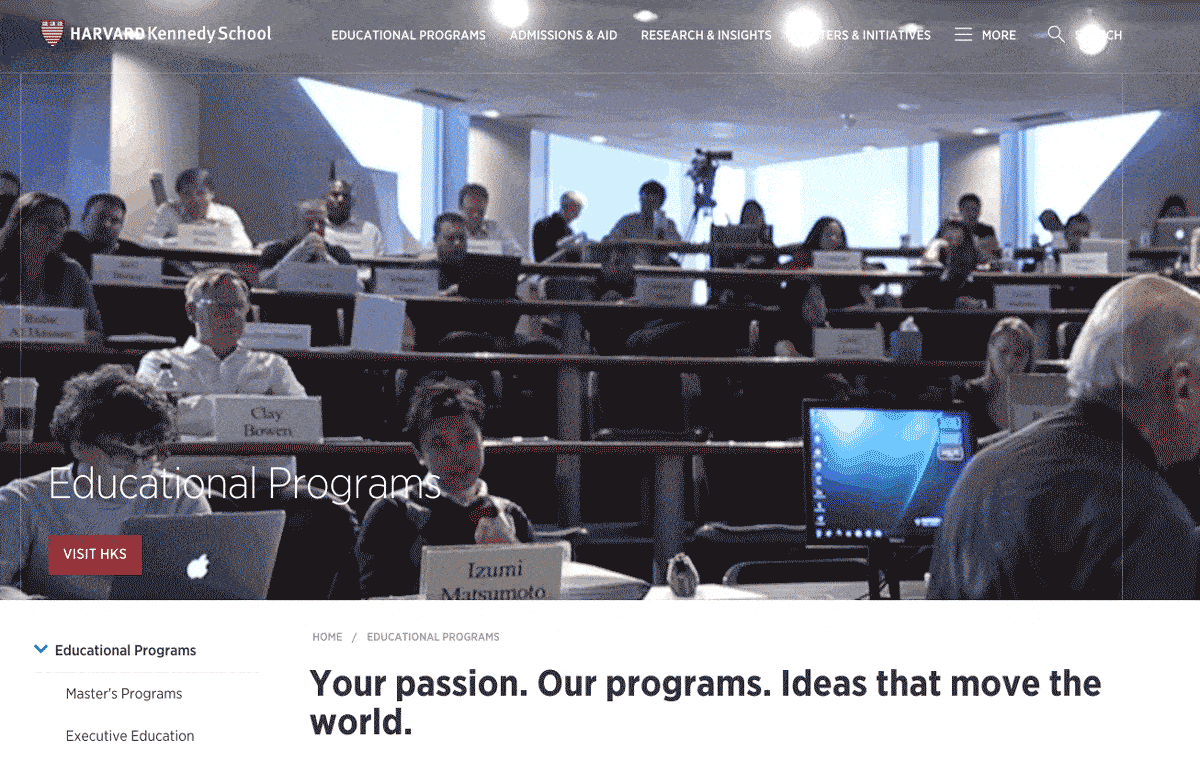
One popular forward-looking feature: "living" video headers.
Our site development model was built on phases. We began with wireframes, mood boards and personas. These progressed to mockups, and eventually a living beta website.
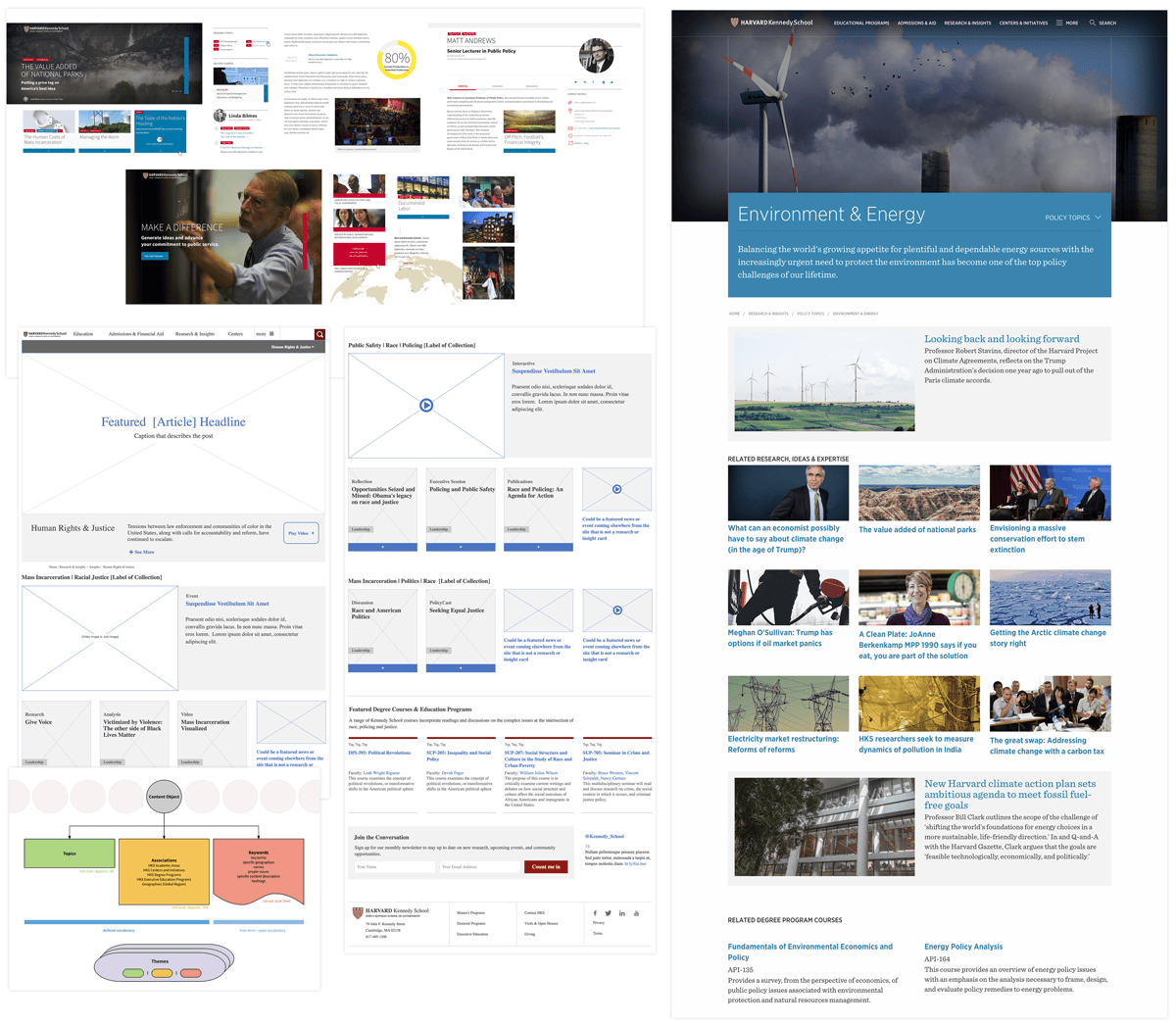
Mood boards, wireframes and taxonomy diagrams (left) converged to create to a living site (right).
In parallel, we organized a systematic approach to migrating, editing and re-writing thousands of pages of legacy web content. Some content needed to be preserved, but wasn’t appropriate to migrate. We devised an archival system to ensure it remained accessible.
The site launched in July of 2017, one of the first Drupal 8 sites in higher education. It features fully-immersive imagery, simplified search, purpose-driven templates for sub-branded pages, a new concentration on taxonomy-driven research content and a clean, thoughtful look across thousands of pages of content.
Give or take a stray oxford comma, the launch was flawless. The site received commendations from the Dean, the Kennedy School and Harvard communities and the general public.
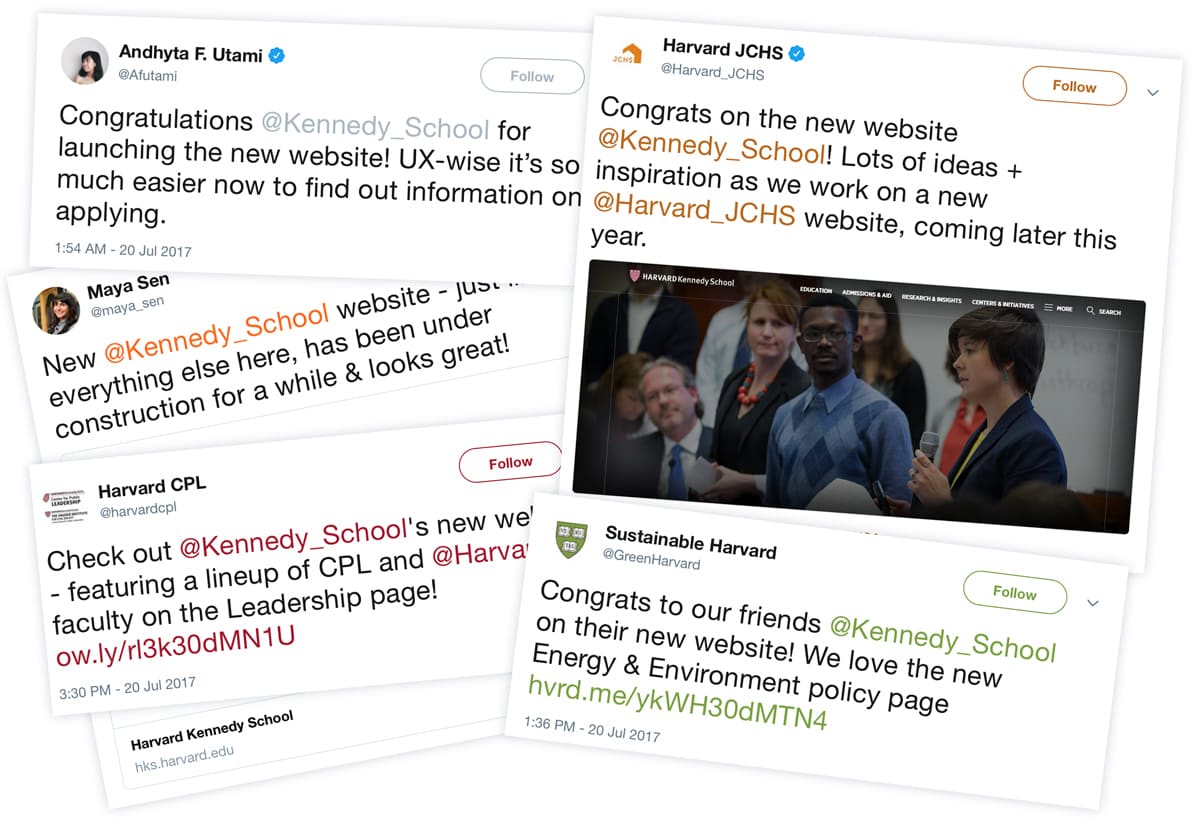
Launching simultaneously with a revitalized Kennedy School campus, the new website serves alongside the school’s new physical spaces to form a singular, human-focused HKS infrastructure.
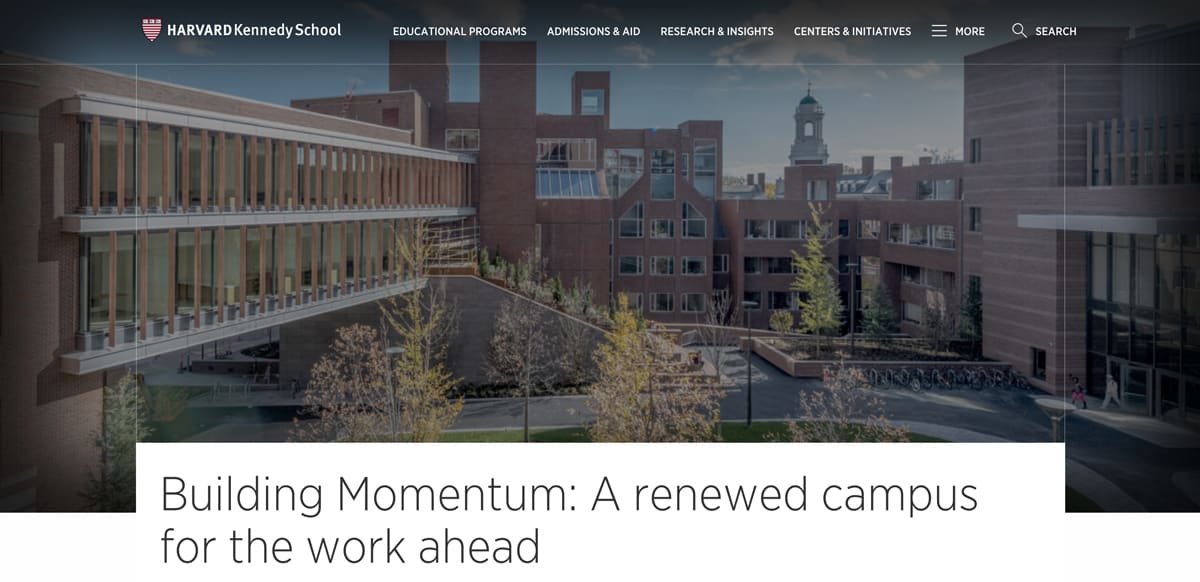
My leadership and contributions to the project were recognized with a Kennedy School Dean’s Award, the highest honor a staff member can receive at HKS. It was my second such recognition.
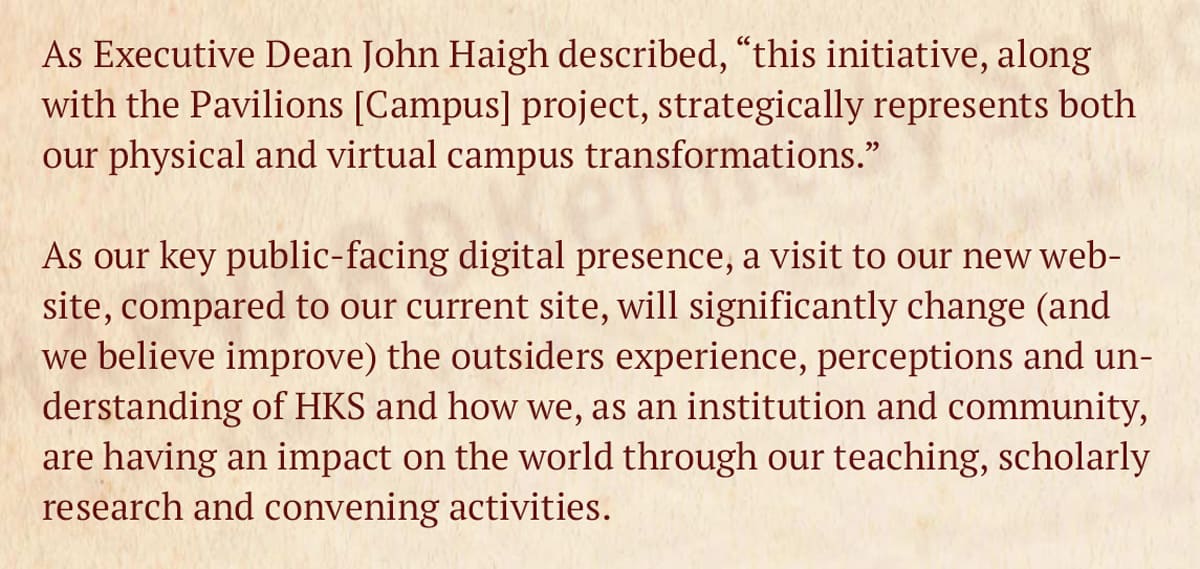
Excerpt from 2017 Dean's Award commendation.
Though my family and I moved from Boston to Philadelphia in 2017, I was asked by HKS leadership to stay on at the school and lead the project into a post-launch phase. Commuting remotely from Philadelphia, I continued to work in my position to set strategy, lead production teams, onboard internal editors, and make sure the site’s post-launch phase was successful. I eventually moved on to new opportunities in mid-2018 with the site and its supporting environment set for a long and prosperous future.
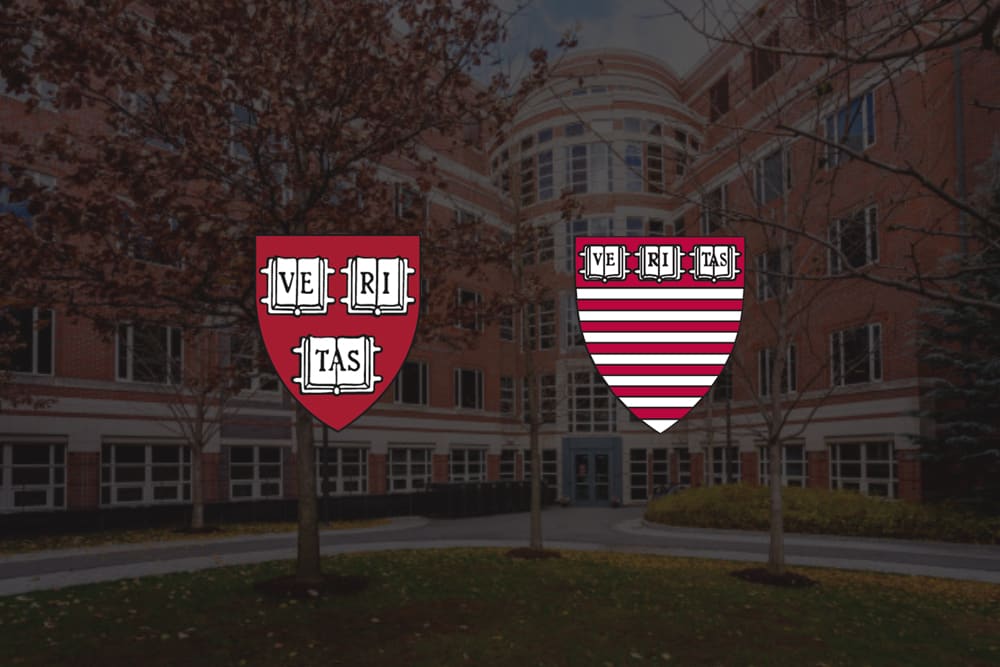
Case study: Product leadership at Harvard
Digital Leadership at Harvard University
From command lines to first-ever tweets, CSS rules to CMS templates, site build-outs to budget projections, content strategy to UX and design, and analytics to community leadership: for a decade, I directed web and digital strategy at Harvard's graduate school of public policy, the Harvard Kennedy School.
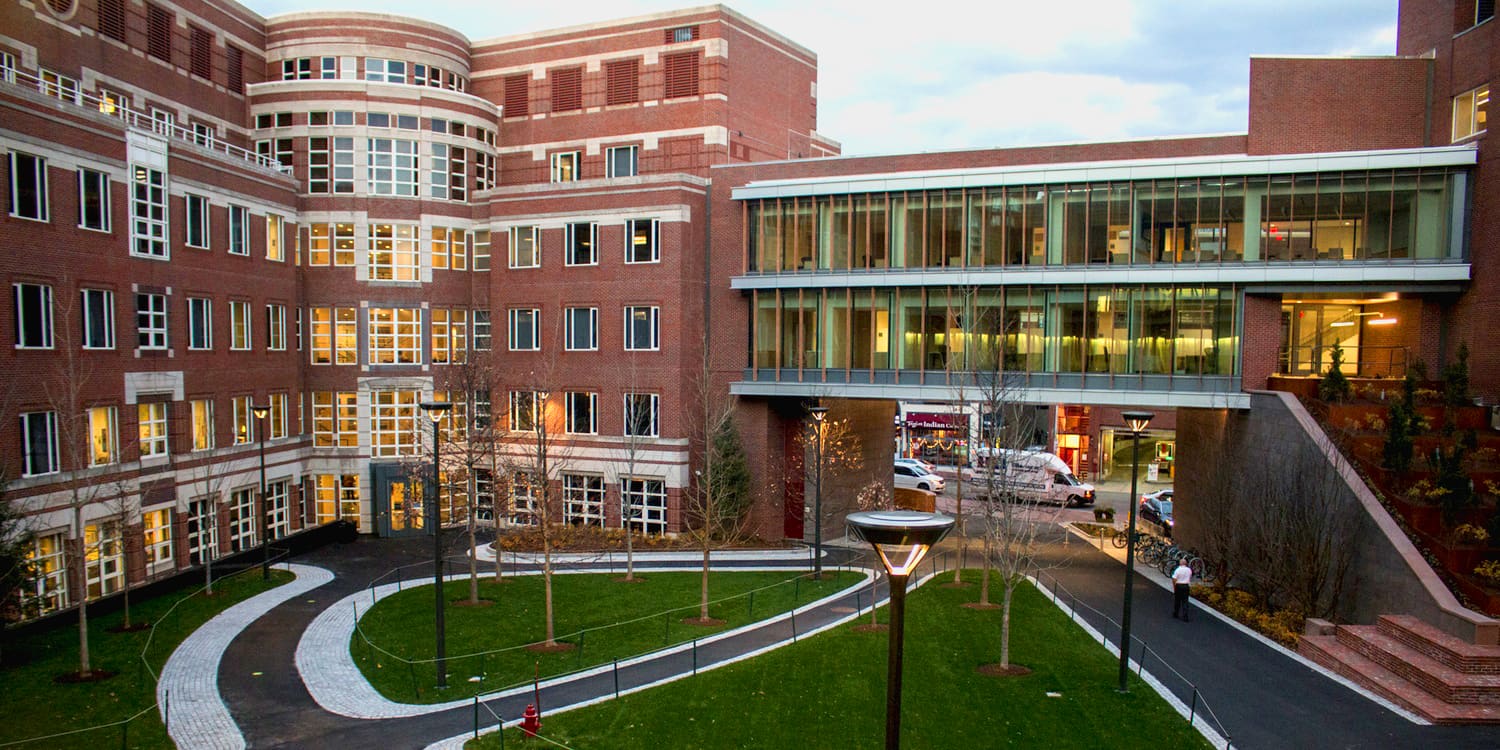
My first week at Harvard’s Kennedy School was the week of the 2008 U.S. Presidential election. It’s no understatement to say that the Kennedy School (being the pre-eminent school of public policy and governmental studies in the world) was an absolutely remarkable place to be at that moment.
In the weeks and months after, I received an unforgettable introduction to politics, scholarship, higher education, and the emerging role digital technology could play in bringing them all to new places.
Over the ensuing 10 years, my job never became less fascinating than it was during that dynamic first week. My time as Associate Director for Web Strategy at Harvard Kennedy School is a career-defining experience that I will always be grateful for.
When I was hired, in late 2008, Harvard Kennedy School had recently completed a primary website revamp. The process that produced the site had taken a toll on HKS – the new web platform was live, but budgets, vendor relationships, and internal departmental dynamics were incredibly strained. What’s more, due to a combination of internal politics and technological fatigue, the new site only hosted some of the school’s digital content. Only certain administrative departments and a few centralized databases (like course listings) had homes on the new web platform. A large percentage of the remaining content was locked up in legacy websites, some ten or twelve years old. I was immediately asked to step into a leadership role for the Kennedy School’s digital and web properties, and to try and expand the new web platform’s reach. My first step was to set about building a framework for sustained success on the web.
Decentralization is the norm at the Kennedy School, at Harvard University, and perhaps throughout all of higher education. Silos, odd interdepartmental relationships, and legacy technologies create a challenging and uneven landscape. Instead of a clear hierarchical reporting structure, large parts of HKS and Harvard are comprised of loosely-tethered, pseudo-autonomous business units. Each unit has their own budget, their own objectives (often driven not by school-wide concerns, but by faculty or donor directives), and often their own brand identity.
When I began, most of these units also had their own completely bespoke websites. And they were not in good shape.
It quickly became clear that my role required a particular and uncommon approach: I was being asked by HKS leadership to bring technology, standardization, and best practices to clients throughout the school who clearly needed web help, but often didn’t ask for it – and who didn’t want to give up independence. Without an excess of tools, budget, personnel or precedent, I began to build a network of relationships and partnerships to help this necessary task move forward.
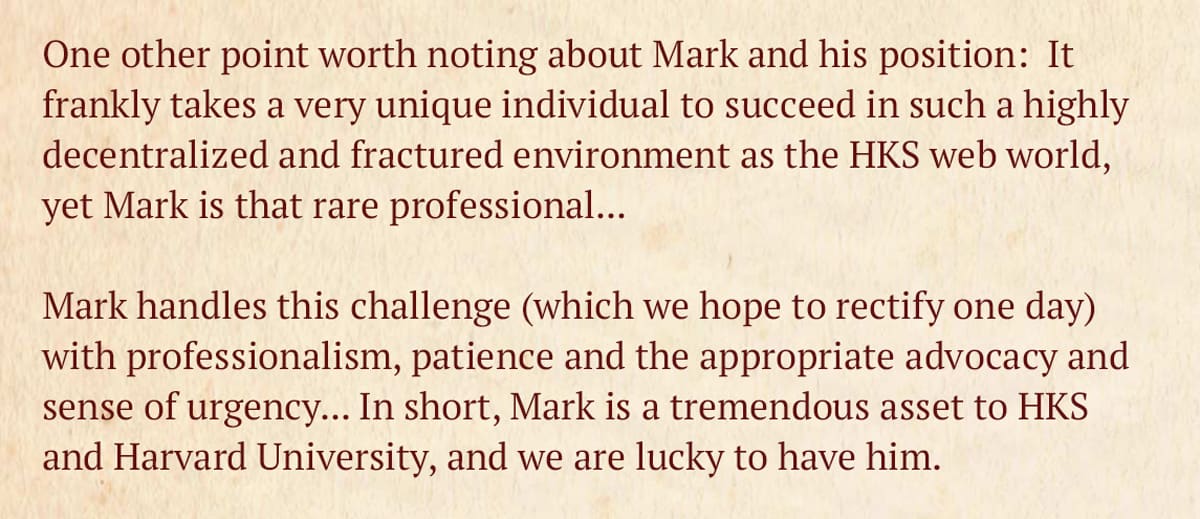
Excerpt from a 2010 performance assessment, as I began to establish success in the decentralized HKS environment.
Within 18 months, I led the migration of three major independent research unit sites to the central HKS web platform. Several dozen such sites would follow over the next 6 years. My approach – a mix of advocacy, training, strategic recommendation and (most importantly) listening – was making progress.
With a background in coding and design, I was often called on to perform hands-on web work during these early migrations. From server administration to writing PHP, HTML, Javascript and CSS to designing graphical layouts and templates, often my direct help meant the difference between a project succeeding or drifting due to lack of technical resources. Over time, I established a school-wide network of content managers, developers, designers and administrators to support these tasks. As successful projects launched, they demonstrated to new stakeholders that technical services were worth budgeting for. By design, the need for my direct participation in coding ebbed. Though my role was always strategic in description, hands-on development was, for a time, a necessary strategic tool.
During this time, my role at HKS grew to encompass leadership. I convened a school-wide affinity group for web and digital users, led training sessions and seminars, frequently reported to school executives and advisory groups, and represented the school at conferences and industry events for digital professionals within Harvard and across the country. I gained experience working with budgets, making projections, and contributing analytics and assessment to briefs and annual documents. In due time, I was asked to take on direct reports, adding a welcome measure of mentorship and management to my role.
Somewhere along the line, I also authored and sent the Kennedy School’s first tweet. (@Kennedy_School now has over 75,000 followers). I recognized the importance of social media early in my tenure, and working with a few like-minded departmental colleagues, I helped create a social media portfolio and strategy for HKS (including a presence on Twitter, Facebook and Youtube) that’s still bearing fruit today.
I won the first of two Dean’s Awards, the highest award bestowed on HKS staff members, in 2014 for my role in leading an effort to bring much-needed upgrades (including a responsive layout) to the school’s by-then aging CMS.
Ultimately, my role at HKS had been building towards one thing: bringing a modern website platform to life. I played a leading role on a school-wide task force charged with planning the next decade of Kennedy School digital priorities. Our report, the HKS Digital Blueprint, ranked a new public website at the top of the priority list. The report was well-received by school leadership.
After several years spent building a budgetary and technological case, funding was allocated to the new website effort in 2015. For the next three years, my role again expanded to include primary strategic and hands-on leadership over this sprawling project, while still maintaining day-to-day responsibility for the older, functioning platform.
I authored the draft of the initial RFP for the project, which was praised both internally and externally for its clarity and sense of vision. Along with a modest project leadership team, I triaged vendor responses, interviewed potential partners, and made recommendations on how best to move forward. I played a leadership role in the formation and direction of what would become a cross-school website project team, and (along with other departmental leaders) served on an advisory group for the project.
For three years, the HKS Public Website Project took up a giant percentage of my professional (and personal) life. I managed budgets, vendors, internal users, and dozens of stakeholder relationships. I reported to executive leadership, created detailed technology plans and managed team turnover. I drafted CMS reviews, content taxonomies, shepherded wireframes, personas, mood boards and mockups towards their ultimate destination – a live, working website. At every step of the way, I was fortunate to work with experienced project managers, detail-oriented reports, capable vendors and visionary leaders from whom I learned a great deal.
The work was often difficult. Pulling up and re-establishing the web presence for thousands of pages and dozens of discrete websites is a tricky business. My strategic leadership often included knowing both how to approach the task at hand, and how to work with the individual stakeholders to make sure they understood the vision and future for their digital presence.

Excerpt from a 2017 performance assessment, noting the specific challenges and my approach.
To much acclaim, the new HKS website – a three-year, six-figure, ten-thousand-page – launched in July of 2017. On day one, fifty internal editors, trained by my team, began using the site to publish new content. Along with the rest of the HKS community, I was ecstatic. The platform currently hosts upwards of four million visitors a year, generates significant revenue in the form of executive education enrollment and donor stewardship, and serves as a calling card for HKS around the world. I’m incredibly proud of the new Kennedy school website, and the colleagues I worked with to bring it to life.
As the project neared its conclusion, my family and I made plans to move away from the Boston area. Harvard Kennedy School leadership asked me to stay on and lead the project into a stable, post-launch phase, even if it meant working remotely. I did so.
In the spring of 2018, the new web platform in strong shape, I said goodbye to the Kennedy School. Looking back, it’s hard to believe just how much we accomplished in the digital and web worlds during my time at the School. Given the unique circumstances of advocating for and building out technology in decentralized higher-ed environments, I’m doubly proud of our real and lasting achievements.
Harvard University is an elite environment – a place that challenges all who associate with it. For almost a decade, I served as a digital leader at Harvard’s Kennedy School, building cutting-edge web platforms, directing diverse teams in decentralized, challenging surroundings, and learning from wonderful, smart colleagues. The time I spent at HKS will always be an honor and an experience that will serve me well as my career moves beyond Cambridge.

Case study: From startups to household names, establishing a winning digital process at Garfield Group and Bailey Brand Consulting
Leading Agency UX & Development
At Bailey Brand Consulting and the Garfield Group, prominent marketing agencies in Philadelphia, I architected change, delighted clients, and raised digital offerings to new levels.
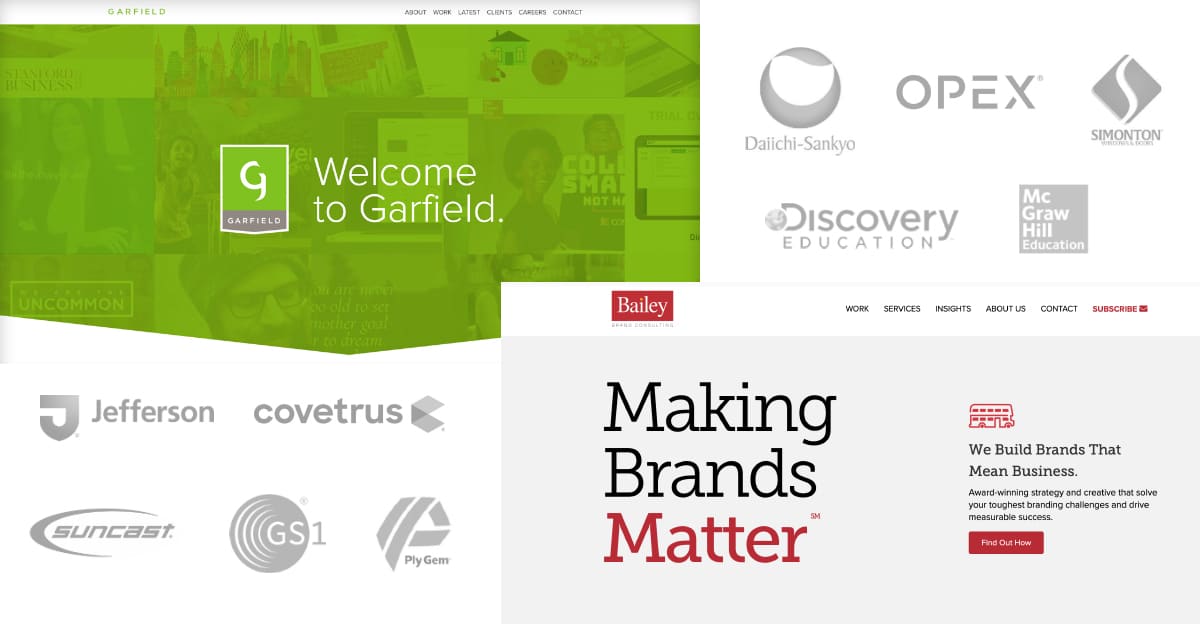
Most agencies do a little of everything. Branding and identity work. Writing. Print collateral. Public Relations. SEO and SEM. And, of course, a ton of design. Digital and UX capabilities, however, don't always come naturally to agencies whose DNA is in traditional design and marketing.
In late 2018, Garfield Group brought me in as a consultant to help them manage two large web builds. I had a chance to observe the processes and workflows they had in place for digital work, and they had an opportunity to get to know me. After getting acquainted, we decided to work together on a regular basis. In 2019, I joined Garfield Group full time to lead and transform their digital operation. As the team’s first-ever Senior Director of Digital Strategy, I did just that.
In 2020, as Garfield was being acquired, I decided to transition to a similar team: Bailey Brand Consulting. Bailey was similar to Garfield in many ways: local prominence, a small but capable team (both shops had under 40 employees, across a range of roles), noteworthy clients, and a lack of digital leadership. Sure, Bailey had made websites for clients, but they didn't have a process in place to build them consistently, and they weren't thinking about digital work as a discipline separate from design. Over four years, I was able to help them change that.
The Before Picture
Both agencies' client bases were made up of a healthy mix of industries: healthcare and pharma, higher education, finance, tech and media. Both Bailey and Garfield were adept at understanding the unique needs each client presented – but were not often, on the digital side, presenting clients with opinionated digital options. Pre-existing client decisions or assumptions often defined builds from the start – meaning agency teams were frequently adapting to work within technical requirements that were already set in stone. The result: no two client builds were similar. Platforms, environments and processes varied from project to project. Development talent was sourced on a project-to-project basis. Neither agency had extensive experience creating an internal digital ecosystem, or a rock-solid set of processes, that could be used and re-used across projects.
My job, at each shop, was three-fold:
• to direct ongoing digital projects
• to help the agency bid on, and win, new business
• to re-imagine and re-architect the way the agency’s digital processes worked.
I did them all, simultaneously, while learning exactly what makes agency life unique.

Just some of the tools and platforms I made frequent use of at Bailey and Garfield.
For one, agency life means identifying the right tool for every job – or, at times, inheriting imperfect solutions and working to make them better. Along the way, you use, and learn, pretty much everything. From WordPress to AWS to Salesforce to Google Analytics to Figma, I know my way around a diverse array of digital tools and platforms. I understand their strengths and weaknesses, which ones work well together and which don’t. Some are brilliant. Some supercharge workflows and promote collaboration. Others can cause headaches, or send a project down a dead end. Yet others are perfect for exactly one type of build.
Like a woodworker with a shelf full of saws, drills, chisels and planes, I understand which situations call for which tools. (And, of course, I have my preferences.) At agencies, I brought that opinionated expertise to bear. On arrival, I began to help each agency develop a T-shaped approach to digital: pursue familiarity and understanding across a broad range of platforms and technologies; foster deep specialization and expertise in a selected few.
Diverse clients, incredible projects.
When I joined Garfield, I expected a rush of work, and a mix of technical requirements (even as we worked to standardize our offerings). But I didn’t expect the sheer variety – both technical and topical – that each client presented. Bailey's client list was similar: big consumer brands and B2B companies mixed with smaller organizations doing local and charitable work.
Since I worked there, Garfield Group has been acquired by BNO. See their current work at BNOinc.com. Bailey Brand Consulting’s work and client list is available at baileygp.com
At Garfield, I helped direct and launch big digital builds for clients across a range of verticals – from education (Discovery Education, McGraw-Hill) to finance (Marlin Capital, 1847 Financial) to media and technology (Kinetiq, 1010Data) to healthcare (Aquity Solutions, Quartesian) to organizations and non-profits (ASTM, Mighty Writers, Urban Tree Connection). At Bailey, I worked with household names (Suncast, Simonton, Ply-Gem), international groups (GS1, Daiichi-Sankyo), and mission-focused organizations (Sidney Kimmel Cancer Center). I defined a straightforward build process that, for the first time, worked across clients, no matter their size or pre-existing factors. It included things like template component reference guides, multi-server workflows, dedicated external quality assurance resources and centralized issue-tracking software. These changes, soon standardized and documented processes, helped ensure delivery exceeded client expectations.
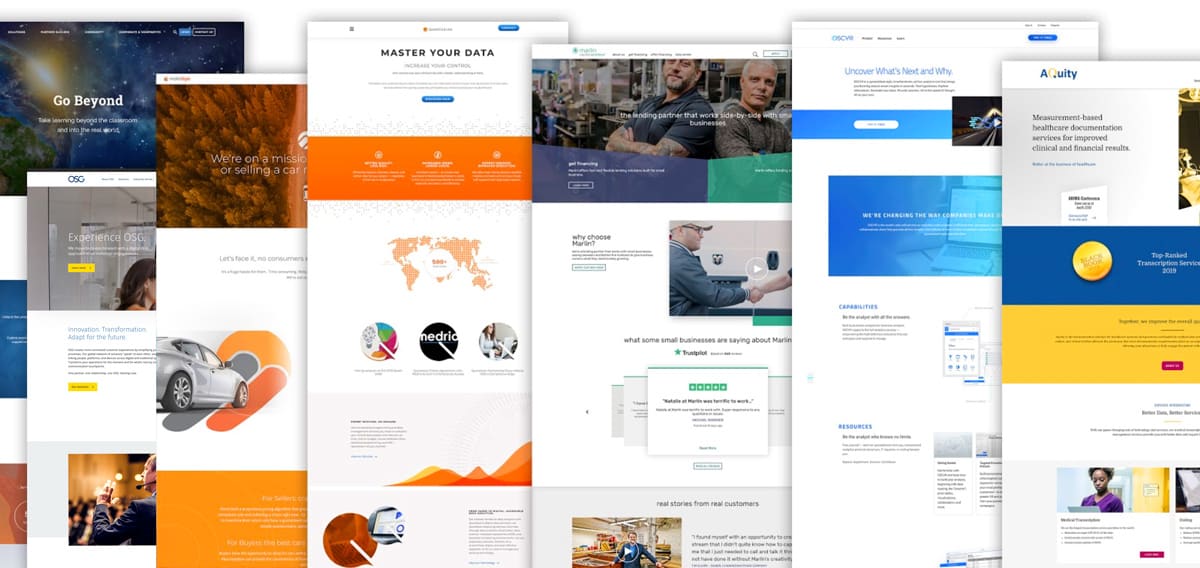
A few of our well-received launches at Garfield Group.
Almost alwasy, the digital products we built became relationships. At both agencies, a majority of our net-new builds transformed into ongoing development retainers that provided a stable, predictable pipeline of digital work. As the face of digital work for both agencies, I communicated directly with clients to help triage and prioritize their digital requests.
UX to the fore.
When I arrived, Bailey Brand Consulting had developers and designers. They had writers, strategists, SEO experts, and even some strong approaches to project management. But they weren't happy with how their digital work had been proceeding. Builds were often challenged by timing, budget and quality control. Process was needed – but the missing piece was more fundamental than that. Bailey needed a strong understanding of user experience, as a discipline. During my time at the agency, I concentrated on leveling up the agencies' UX capability. We started by streamlining a development process into a cross-functional team that allowed designers, devleopers and strategists to work together instead of in silos, passing batons back and forth. Working with leadership, I continued to add to that team, hiring a UX researcher so that we would be able to systematically rely on the voice of the user across all build processes. We went further, ensuring that all digital team members received a stringent UX certification from Nielsen Norman Group, a leading UX advocacy organization. As we adapted to UX as a discipline, and began placing it at the center of everything we did, Bailey's output improved dramatically. As a result, we tackled incredible projects.
A focus on process.
Garfield Group offered, as some might call it, a blue-sky opportunity to define digital processes and workflow. There wasn’t much in the way of digital process at the agency when I arrived. Client projects were built using stacks, and on top of platforms, and with deployment processes, that (as mentioned above) tended to vary wildly. This weighed on the business in several ways. Productivity suffered. The chance to build expertise stalled. Unnecessary risk arose from the lack of documented structure.
While working to keep our production moving, I also implemented high-level changes. First, I centered the agency on a specific recommended stack for digital builds: WordPress with Bootstrap for CMS, Pardot/Salesforce for marketing automation and lead capture, Google for analytics and business intelligence, and Pantheon as a deployment platform. We continued to use, and need, other tech (Drupal, Marketo, Hubspot, WPEngine, AWS/EC2, etc.), especially for clients with whom we had ongoing maintenance relationships, or for clients who absolutely needed specific technologies. Defining our preferred stack, however, afforded many clients a real feeling of relief: the pressure of weighing different options themselves, when many didn’t have a strong preference or digital experience, was exhausting.
For Garfield, the benefits were enormous. We were able to standardize most of our builds on a single deployment platform, Pantheon, which made it straightforward to introduce a raft of process upgrades to all clients. These included getting everyone on Git repositories, an automated backup schedule, a dev-staging-live workflow, and a development cadence that included regular patches and upgrades. Many clients had not enjoyed these benefits before, and Garfield was able to own those changes – leading to goodwill, deeper trust and ongoing work. The agency deepened its expertise and became very nimble, especially at getting new projects up and running. It also made the business massively more efficient by enabling us to cut redundant platforms (and hence, licenses, training, technical debt, etc.) from our balance sheet.
I didn’t stop there.
I went on to create, and document, a granular, step-by-step process for all digital builds. This Digital Process doc defined responsibilities and accountabilities across every agency team (design, development, copy, strategy, performance marketing, account and quality assurance) and documented how they would ideally come together on a digital project. The detailed internal version guided processes at the agency; a high-level client-facing version also helped explain our process to the outside world.
Where Garfield had relied on email, documents and spreadsheets to manage development projects, I introduced baseline tools for issue tracking (a hybrid sprint/kanban system using Jetbrains’ YouTrack) and implemented it across all clients and projects.
Where Garfield had relied on a mix of internal developers and freelance resources to augment their team, I fostered a relationship with a dedicated third-party development firm to provide on-demand, cost-effective development talent who got to know our processes and clients closely.
And where Garfield relied on a surfeit of older, siloed apps and one-off workflows, I standardized the digital team on a set of modern tools (including Figma for design collaboration, Elementor for visual templating and wireframing, YouTrack for issue triage, BrowserStack and Litmus for testing, etc.).
The result, after just two years, was an ordered, manageable digital landscape.
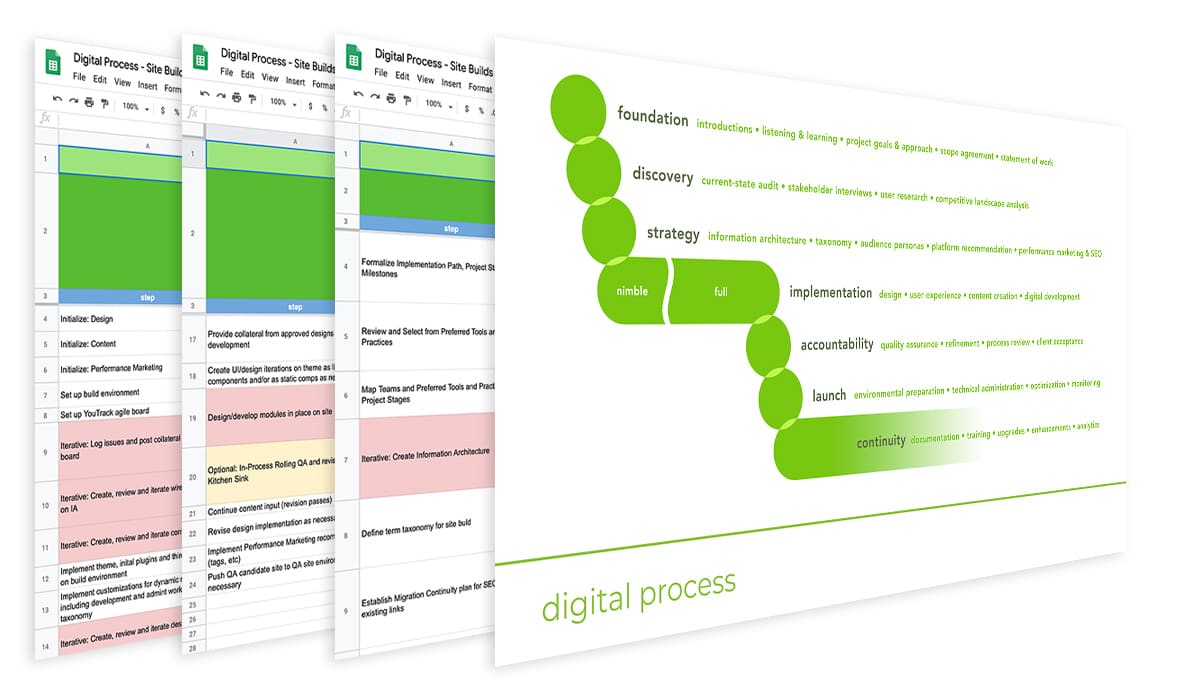
I created a range of detailed and high-level process documentation.
There is a season for everything. From COVID-19 to geopolitical changes to new technologies to the whims of client strategy, the work agencies do is constantly being upended and disrupted. When digital work becomes unpredictable things can change quickly. In a challenging landscape, I left Bailey in the spring of 2025 to work on new mission-driven opportunities as an independent consultant. I’ll always be appreciative for my time directing digital projects and strategy at Bailey and Garfield (and I’m happy to be back working with them as a consultant as they need me). The people who drive each agency are set to flourish in the digital space – and I’ll be watching with pride as they do.

Case study: A focus on mission-driven work
Mission-Driven Digital
Across two decades in digital strategy and design, I’ve sought out roles that align with one core value: doing meaningful work for people who are doing meaningful work themselves.
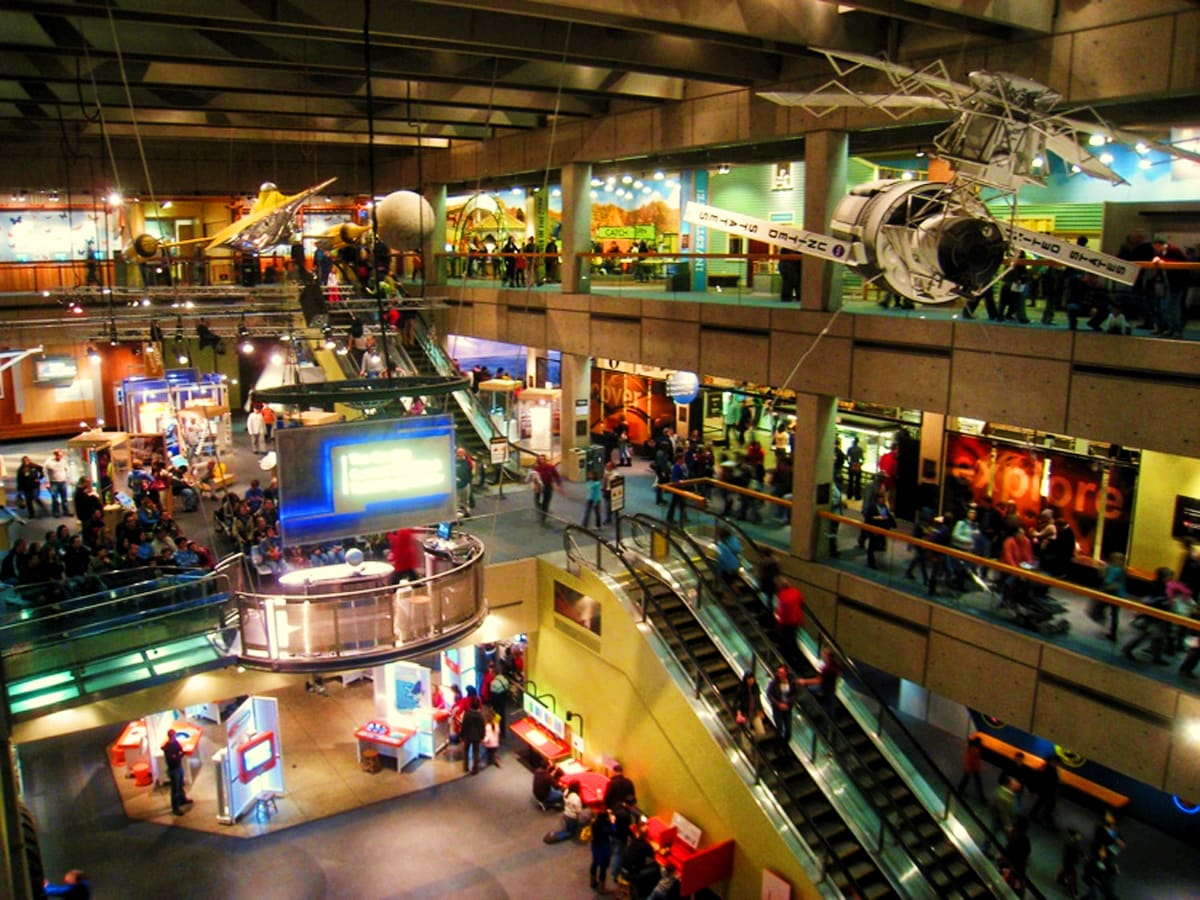
A busy day at the Museum of Science, Boston, where I directed web work early in my career.
I care deeply about people and organizations who want to make the world a little better. My career began at Elderhostel, now Road Scholar, a non-profit organization focused on lifelong learning and empathetic travel. Following roles at the Museum of Science (Boston) and Harvard University cemented the idea that I do my best work when I'm reaching for a goal that's larger than myself and more important than the bottom line. As I've through my professional life, I've always kept mission-oriented work at the heart of what I do. It's what I'm best at.
Elderhostel / Road Scholar
At the very start of my career, I directed web strategy for this lifelong learning nonprofit. I helped bring their legacy of educational travel into the digital era, shaping how their community of older learners found and joined new adventures.
Museum of Science, Boston
As Web Director, I helped reimagine the museum’s online presence. I collaborated across departments—science education, exhibits, outreach, and fundraising—to deliver a public platform that supported the museum’s mission of making science engaging and approachable for all.
Harvard Kennedy School
I spent a decade leading digital strategy at one of the world’s foremost public policy schools. My team launched a unified platform for 40+ centers and programs, each with a distinct academic and civic mission. We rebuilt the public-facing site, integrated content strategy, UX, and infrastructure, and made the school’s impact more accessible.
Product direction for mission-oriented organizations
I recently led UX and strategy for a digital portal that connected Sidney Kimmel Cancer Center's patients to care and support at one of the region’s top hospitals. Built for ease, clarity, and compassion, the tool helped people navigate a difficult time with more confidence and less friction.
I’ve also worked with, and built products for, many smaller organizations and mission-driven clients. I bring the same care to limited-budget projects as I do to institutional ones. A few favorites:
- Mighty Writers – working at Garfield Group, I built a website to raise funds for a beloved Philly literacy nonprofit.
- Urban Tree Connection – also at Garfield, I built a site that helped this Philly-based urban farming collective share their story.
- Advisory Network for Small Business – at Bailey Brand Consulting, I directed the build of a site for ANSB, a grassroots initiative that supports local entreprenneurs and minority-owned businesses.
- Greater Glenside Patriotic Association – I design for schools and civic organizations in my community. Each year, I create the official t-shirt for the oldest Fourth of July parade in the U.S.
My best work happens when I’m embedded in organizations doing work that matters—and can use digital design, content, and technology to help them succeed. Whether it’s launching a research hub, building a youth-focused website, or creating systems that make internal teams more effective, I’m most engaged when the mission is real, and the outcomes affect lives.
I direct high-profile digital product builds, including strategy, UX, design, development, implementation and iterative improvement. Examples of recent product direction:
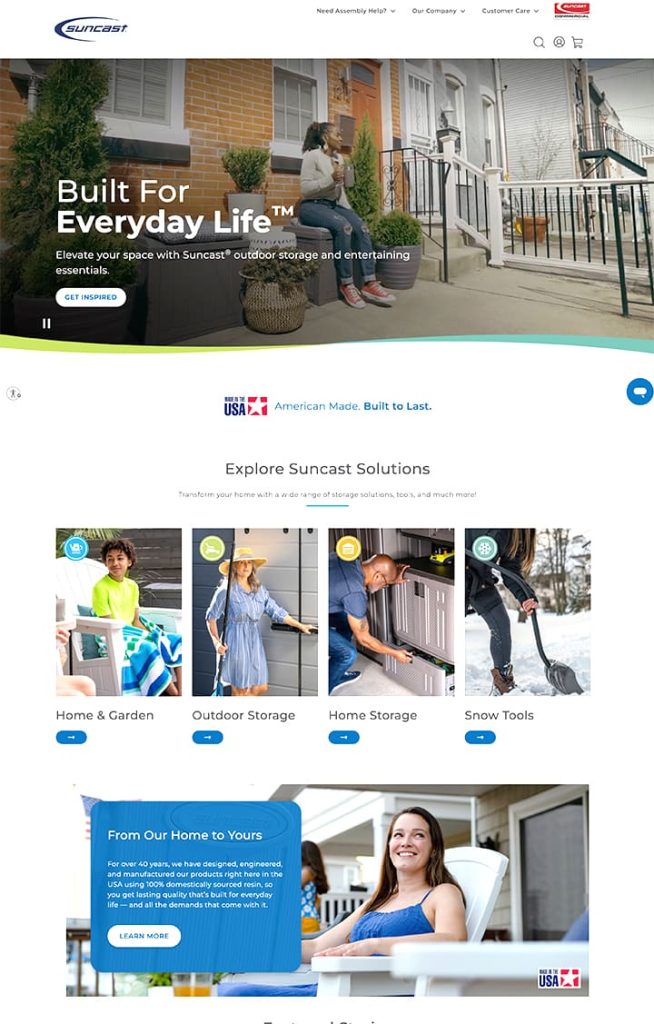
product detail page UX revamp: Suncast.com
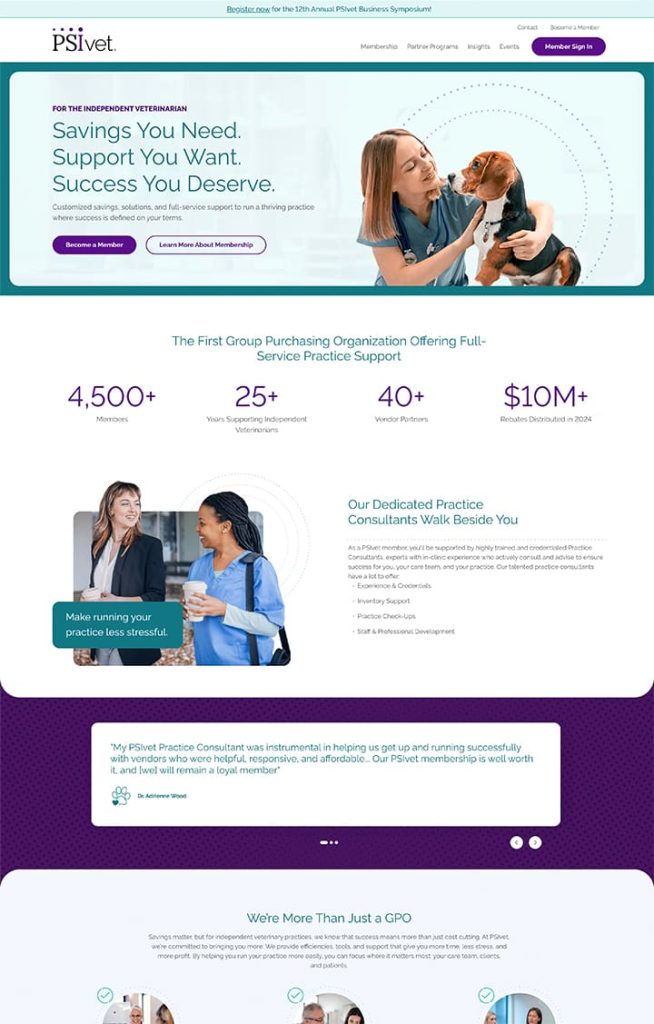
website build, including API-driven customer portal: PSIvet.com
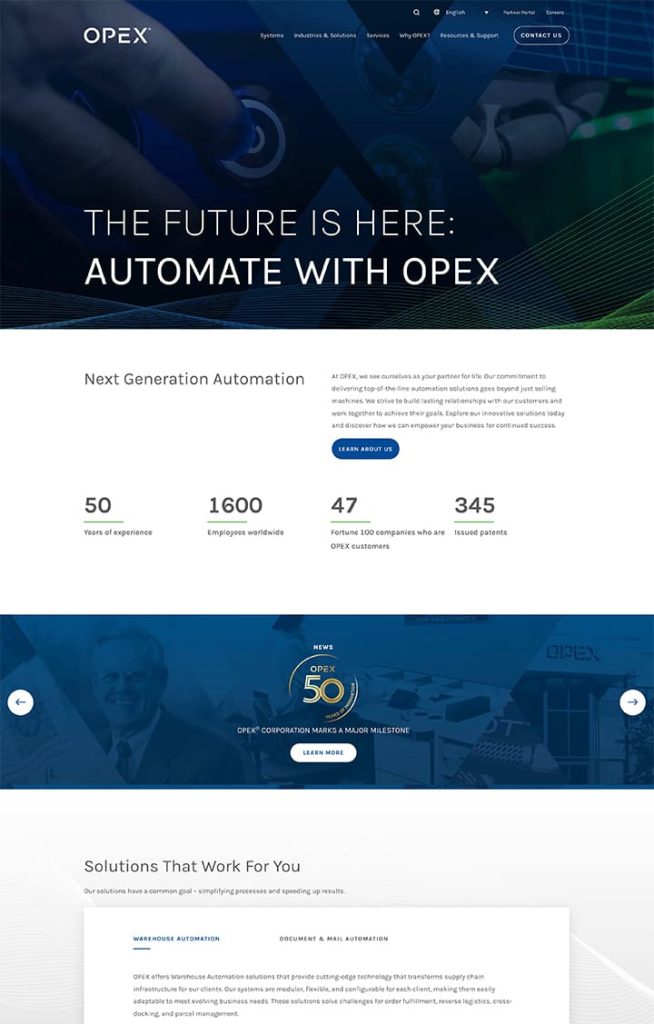
website rebuild, including UX, design and internationalization: OPEX.com
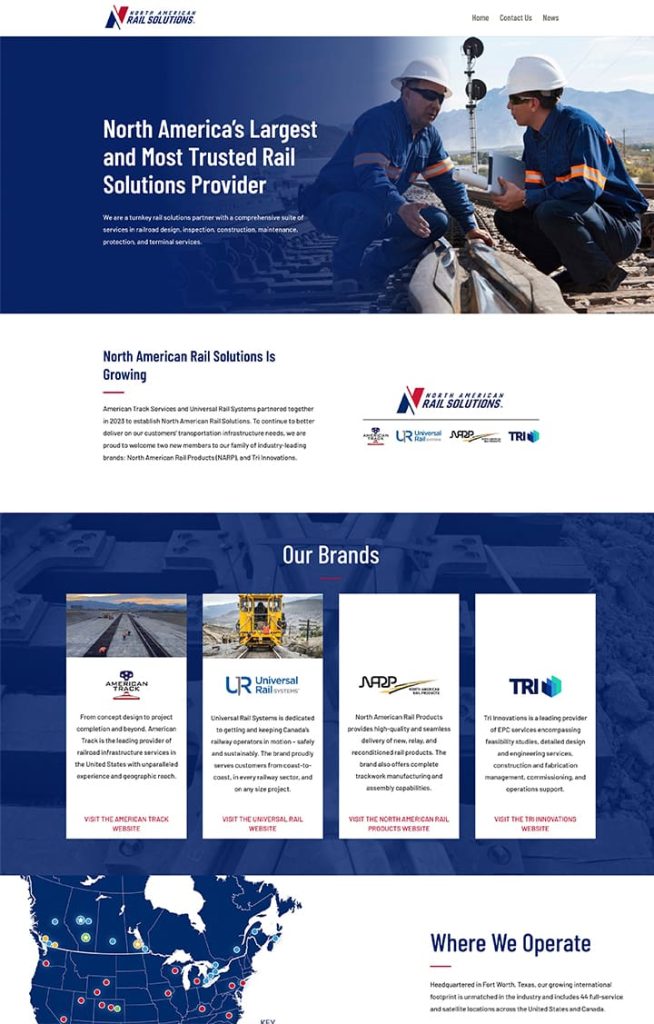
website build: North American Rail Systems
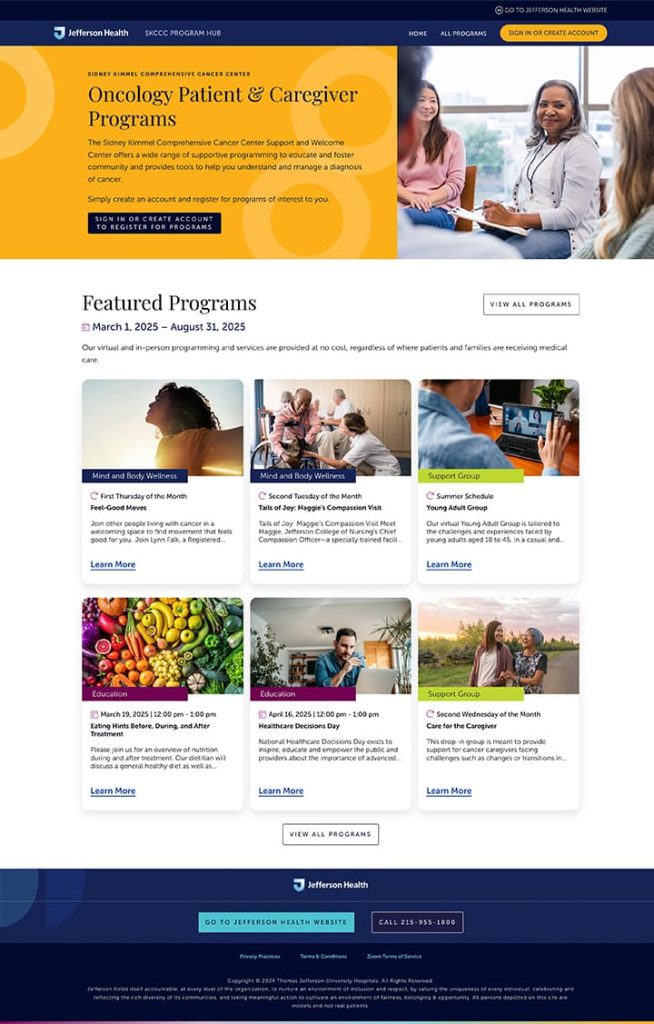
patient portal build, including Zoom integration and reporting dashboards: Sidney Kimmel Comprehensive Cancer Center at Jefferson Health
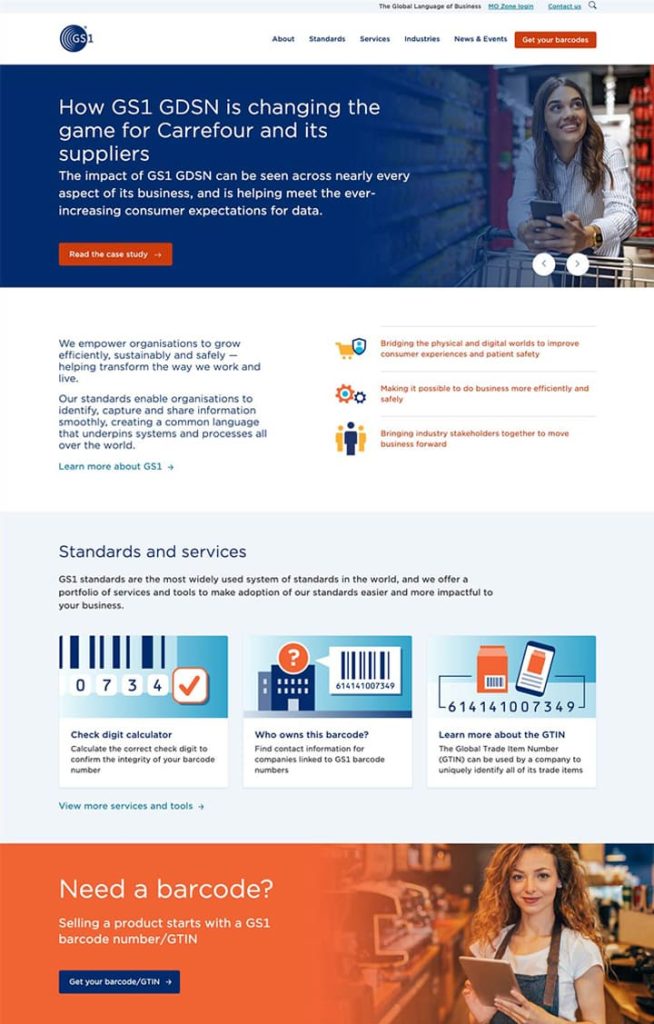
UX revamps to search interfaces; flagship event website build: GS1.org
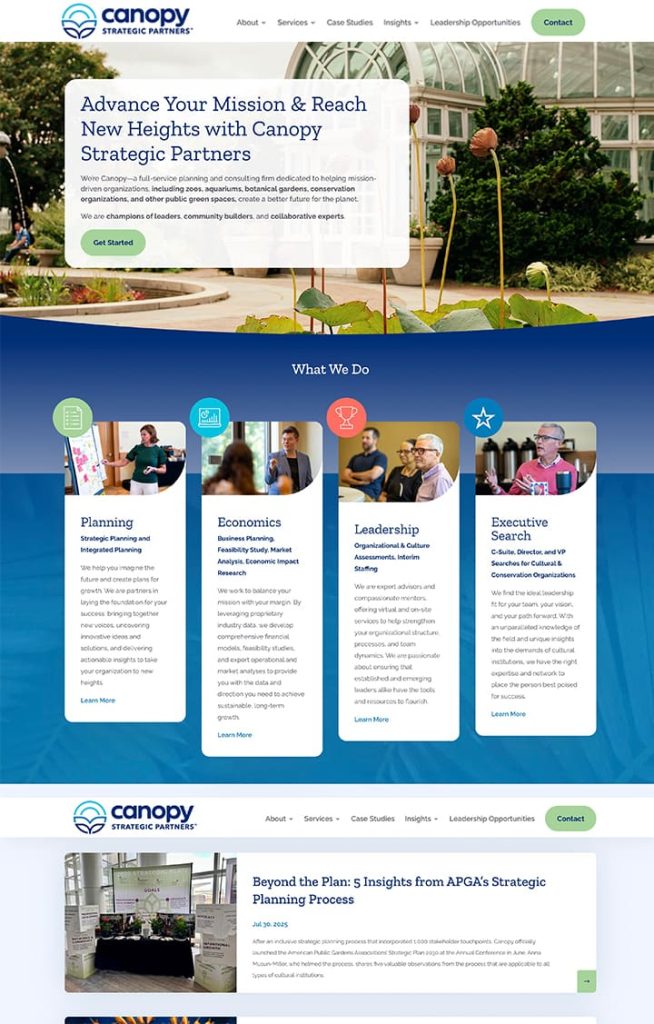
website build: Canopy Strategic Partners
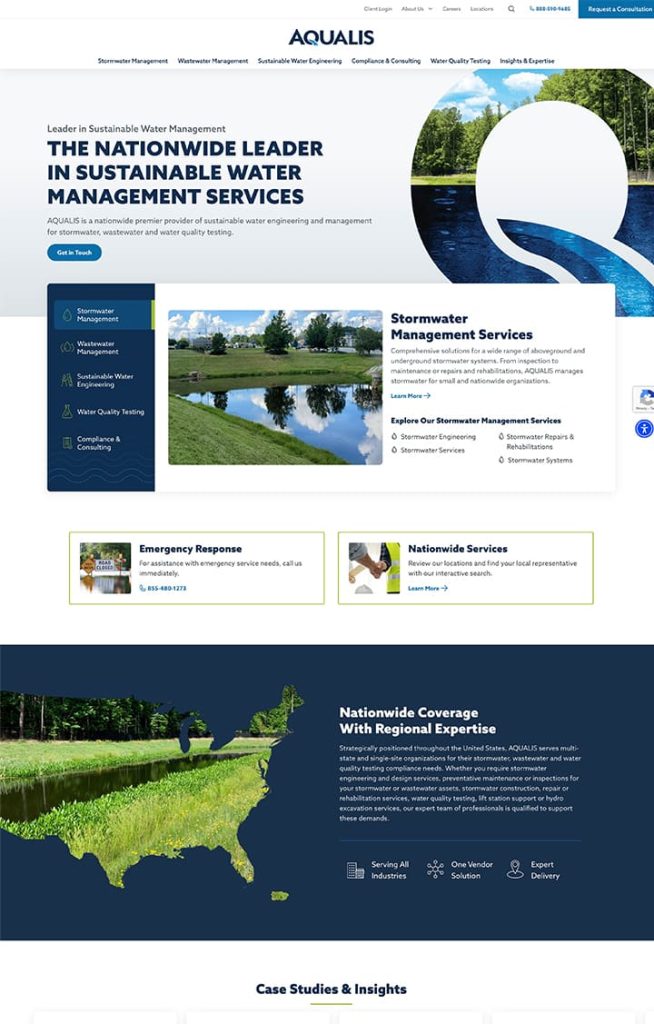
website build: Aqualisco.com
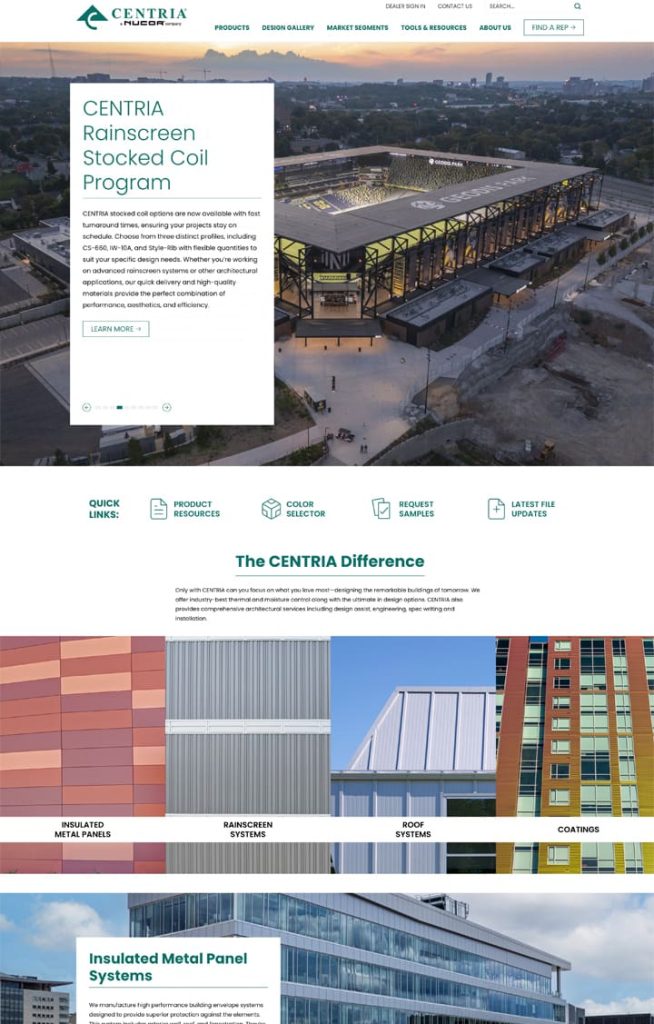
website build: Centria.com
Case study: Creating Harvard Kennedy School’s flagship website and digital ecosystem